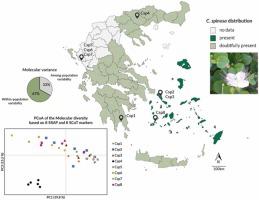Journal of Applied Research on Medicinal and Aromatic Plants ( IF 3.9 ) Pub Date : 2023-04-14 , DOI: 10.1016/j.jarmap.2023.100487 Stella Pegiou , Panagiotis Raptis , Ioannis Zafeiriou , Alexios N. Polidoros , Photini V. Mylona

|
Capparis spinosa is an orphan shrub widely distributed in various landscapes in the Mediterranean basin and in Asia. The medicinal and culinary value of its products has gained the scientific interest, however due to small-scale efforts for caper cultivation, caper parts are largely collected uncontrollably from wild germplasm, exposing natural populations to bottleneck events. Assessment of the species’ genetic diversity is pivotal for the design of conservation schemes. DNA barcoding of 8 C. spinosa populations, collected from various landscapes in Greece was verified by ITS2, matK and trnL-trnF markers and morphological characterization revealed significant differences regarding the leaf length, width, weight, and the length of internodes (Wilk’s λ=0.002, p<0.001), as well as significant correlations between the population’s genotype and the internodal length (R=0.4, p<0.05). Molecular genetic characterization with 8 SRAP and 8 SCoT markers revealed low diversity indices (Shannon’s I= 0.28, h=0.19). The Analysis of Molecular Variance (AMOVA) suggests that 67% of the variability is detected within each population (p<0.001), while STRUCTURE analysis inferred the existence of 3 distinct populations, indicating admixtures in 4 populations from southern Greece. The results of this study corroborate the necessity for thorough caper germplasm characterization and deployment of a conservation strategy of Greek wild populations to safeguard the species’ diversity.
中文翻译:

使用形态学和分子标记的 Capparis spinosa L. 自然种群的遗传多样性和结构
Capparis spinosa是一种孤儿灌木,广泛分布于地中海盆地和亚洲的各种景观中。其产品的药用和烹饪价值引起了科学界的关注,但由于刺山柑的小规模种植努力,刺山柑的部分大部分不受控制地从野生种质中收集,使自然种群面临瓶颈事件。物种遗传多样性的评估对于保护计划的设计至关重要。通过ITS2、matK和trnL-trnF验证了从希腊不同景观中收集的8 个C. spinosa种群的 DNA 条形码 标记和形态特征揭示了叶长、宽度、重量和节间长度的显着差异(Wilk's λ=0.002,p<0.001),以及种群基因型与节间长度之间的显着相关性(R=0.4,p<0.05)。具有 8 个 SRAP 和 8 个 SCoT 标记的分子遗传学特征显示多样性指数较低(Shannon's I= 0.28,h=0.19)。分子方差分析 (AMOVA) 表明在每个群体中检测到 67% 的变异性 ( p<0.001), 而 STRUCTURE 分析推断存在 3 个不同的种群, 表明来自希腊南部的 4 个种群存在混合。这项研究的结果证实了对刺山柑种质资源进行彻底表征和部署希腊野生种群保护策略以保护物种多样性的必要性。



























 京公网安备 11010802027423号
京公网安备 11010802027423号